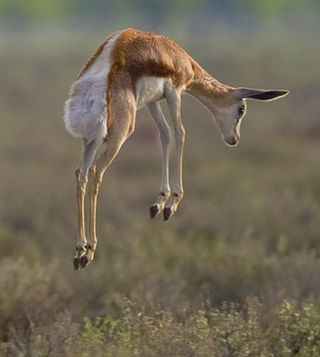
Antidorcas is a genus of antelope that includes the living springbok and several fossil species.

Titanotylopus is an extinct genus of camel, endemic to North America from the late Hemphillian stage of the Miocene through the Irvingtonian stage of the Pleistocene. It was one of the last surviving North American camels; after its extinction, only Camelops remained.

Boreaspis is an extinct genus of osteostracan agnathan vertebrate that lived in the Devonian period.

The Antilocapridae are a family of ruminant artiodactyls endemic to North America. Their closest extant relatives are the giraffids. Only one species, the pronghorn, is living today; all other members of the family are extinct. The living pronghorn is a small ruminant mammal resembling an antelope.

Eobasileus cornutus was a prehistoric species of dinocerate mammal.

Diacodexis is an extinct genus of small herbivorous mammals belonging to the family Diacodexeidae that lived in North America, Europe and Pakistan from 55.4 mya to 46.2 mya and existing for approximately 9.2 million years.

Syndyoceras is a small extinct genus of Artiodactyla, of the family Protoceratidae, endemic to central North America from the Miocene epoch, existing for approximately 4.2 million years.
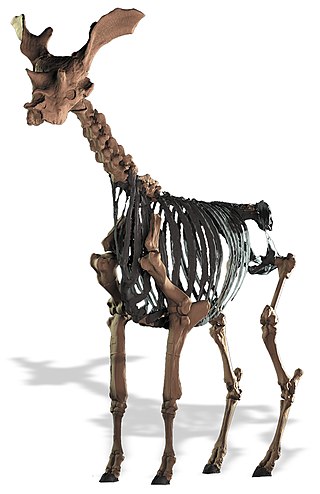
Sivatherium is an extinct genus of giraffid that ranged throughout Africa and Eurasia. The species Sivatherium giganteum is, by weight, one of the largest giraffids known, and also one of the largest ruminants of all time.

Taurotragus is a genus of giant antelopes of the African savanna, commonly known as elands. It contains two species: the common eland T. oryx and the giant eland T. derbianus.
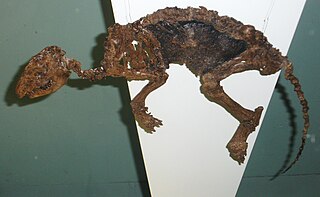
Dichobunidae is an extinct family of basal artiodactyl mammals from the early Eocene to late Oligocene of North America, Europe, and Asia. The Dichobunidae include some of the earliest known artiodactyls, such as Diacodexis.

Protoceratidae is an extinct family of herbivorous North American artiodactyls that lived during the Eocene through Pliocene. While early members of the group were hornless, in later members males developed elaborate cranial ornamentation. They are variously allied with Ruminantia or Tylopoda.
Canthumeryx is an extinct genus of primitive giraffid artiodactyls. It is the close ancestor of giraffes.
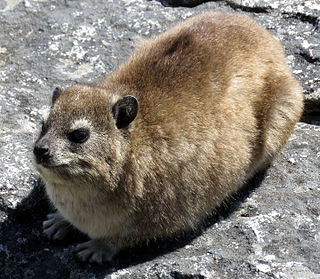
Hyraxes, also called dassies, are small, stout, thickset, herbivorous mammals in the family Procaviidae within the order Hyracoidea. Hyraxes are well-furred, rotund animals with short tails. Modern hyraxes are typically between 30 and 70 cm in length and weigh between 2 and 5 kg. They are superficially similar to marmots, or over-large pikas, but are much more closely related to elephants and sirenians. Hyraxes have a life span from nine to 14 years. Both types of "rock" hyrax live on rock outcrops, including cliffs in Ethiopia and isolated granite outcrops called koppies in southern Africa.
Paraxiphodon is an extinct genus of artiodactyl from the Late Eocene of France. There are two included species, P. teulonensis and P. cournovensis. The genus demonstrated the continued existence of xiphodonts into at least the Lower Oligocene.

Listriodon is an extinct genus of pig-like animals that lived in Eurasia during the Miocene.
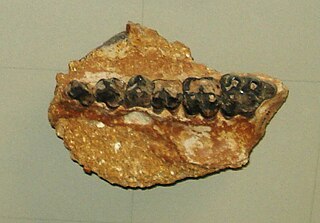
Bunolistriodon is an extinct genus of pig-like animals from Eurasia and Africa during the Miocene.

Homacodontidae is an extinct family of basal artiodactyl mammals from the early Eocene to late Oligocene of North America, Europe, and Asia.

Helohyidae were a group of artiodactyl mammals. They were most prominent in the mid-to-upper Eocene.
Saotherium is an extinct genus of hippopotamid from the Early Pliocene of Africa, specifically Chad. It is represented by a single species, S. mingoz. The earliest fossils appear at the start of the Pliocene, while the latest are dated to about 4 mya.

Ancodonta is an infraorder of artiodactyl ungulates including modern hippopotamus and all mammals closer to hippos than to cetaceans (whales). Ancodonts first appeared in the Middle Eocene, with some of the earliest representatives found in fossil deposits in Southeast Asia. Throughout their evolutionary history they have occupied different browsing and grazing niches in North America, Eurasia and Africa. The last continent is notable as they were among the first laurasiatherian mammals to have migrated to Africa from Europe, where they competed with the native afrothere herbivores for the same niches. Of the nearly 50 genera that have existed, only two of them are extant – Choeropsis and Hippopotamus. The interrelationships within the ancodonts has been contended. The traditional notion is that there at minimum two families Anthracotheriidae and Hippopotamidae and were merely sister taxa. However many detailed research of the dentition among ancodonts, as well as how some anthracotheres were similar to hippos in appearance, lead the current consensus where Anthracotheriidae is paraphyletic to Hippopotamidae. Among the anthracotheres, members of Bothriodontinae are among the closest to the ancestry of hippos, with the Oligocene aged Epirigenys from Lokon, Turkana, Kenya being the sister taxon to hippos. In response of this many similar clade names have been used for this clade.



















